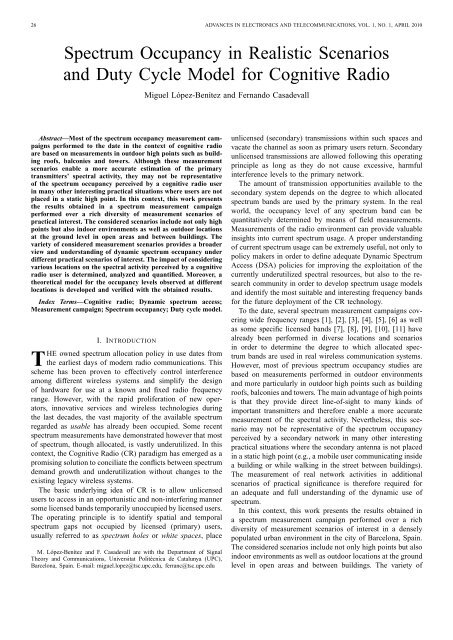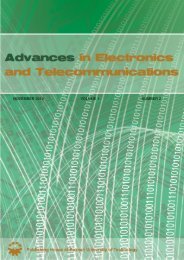channel - Advances in Electronics and Telecommunications
channel - Advances in Electronics and Telecommunications
channel - Advances in Electronics and Telecommunications
You also want an ePaper? Increase the reach of your titles
YUMPU automatically turns print PDFs into web optimized ePapers that Google loves.
26 ADVANCES IN ELECTRONICS AND TELECOMMUNICATIONS, VOL. 1, NO. 1, APRIL 2010<br />
Spectrum Occupancy <strong>in</strong> Realistic Scenarios<br />
<strong>and</strong> Duty Cycle Model for Cognitive Radio<br />
Abstract—Most of the spectrum occupancy measurement campaigns<br />
performed to the date <strong>in</strong> the context of cognitive radio<br />
are based on measurements <strong>in</strong> outdoor high po<strong>in</strong>ts such as build<strong>in</strong>g<br />
roofs, balconies <strong>and</strong> towers. Although these measurement<br />
scenarios enable a more accurate estimation of the primary<br />
transmitters’ spectral activity, they may not be representative<br />
of the spectrum occupancy perceived by a cognitive radio user<br />
<strong>in</strong> many other <strong>in</strong>terest<strong>in</strong>g practical situations where users are not<br />
placed <strong>in</strong> a static high po<strong>in</strong>t. In this context, this work presents<br />
the results obta<strong>in</strong>ed <strong>in</strong> a spectrum measurement campaign<br />
performed over a rich diversity of measurement scenarios of<br />
practical <strong>in</strong>terest. The considered scenarios <strong>in</strong>clude not only high<br />
po<strong>in</strong>ts but also <strong>in</strong>door environments as well as outdoor locations<br />
at the ground level <strong>in</strong> open areas <strong>and</strong> between build<strong>in</strong>gs. The<br />
variety of considered measurement scenarios provides a broader<br />
view <strong>and</strong> underst<strong>and</strong><strong>in</strong>g of dynamic spectrum occupancy under<br />
different practical scenarios of <strong>in</strong>terest. The impact of consider<strong>in</strong>g<br />
various locations on the spectral activity perceived by a cognitive<br />
radio user is determ<strong>in</strong>ed, analyzed <strong>and</strong> quantified. Moreover, a<br />
theoretical model for the occupancy levels observed at different<br />
locations is developed <strong>and</strong> verified with the obta<strong>in</strong>ed results.<br />
Index Terms—Cognitive radio; Dynamic spectrum access;<br />
Measurement campaign; Spectrum occupancy; Duty cycle model.<br />
I. INTRODUCTION<br />
THE owned spectrum allocation policy <strong>in</strong> use dates from<br />
the earliest days of modern radio communications. This<br />
scheme has been proven to effectively control <strong>in</strong>terference<br />
among different wireless systems <strong>and</strong> simplify the design<br />
of hardware for use at a known <strong>and</strong> fixed radio frequency<br />
range. However, with the rapid proliferation of new operators,<br />
<strong>in</strong>novative services <strong>and</strong> wireless technologies dur<strong>in</strong>g<br />
the last decades, the vast majority of the available spectrum<br />
regarded as usable has already been occupied. Some recent<br />
spectrum measurements have demonstrated however that most<br />
of spectrum, though allocated, is vastly underutilized. In this<br />
context, the Cognitive Radio (CR) paradigm has emerged as a<br />
promis<strong>in</strong>g solution to conciliate the conflicts between spectrum<br />
dem<strong>and</strong> growth <strong>and</strong> underutilization without changes to the<br />
exist<strong>in</strong>g legacy wireless systems.<br />
The basic underly<strong>in</strong>g idea of CR is to allow unlicensed<br />
users to access <strong>in</strong> an opportunistic <strong>and</strong> non-<strong>in</strong>terfer<strong>in</strong>g manner<br />
some licensed b<strong>and</strong>s temporarily unoccupied by licensed users.<br />
The operat<strong>in</strong>g pr<strong>in</strong>ciple is to identify spatial <strong>and</strong> temporal<br />
spectrum gaps not occupied by licensed (primary) users,<br />
usually referred to as spectrum holes or white spaces, place<br />
M. López-Benítez <strong>and</strong> F. Casadevall are with the Department of Signal<br />
Theory <strong>and</strong> Communications, Universitat Politècnica de Catalunya (UPC),<br />
Barcelona, Spa<strong>in</strong>. E-mail: miguel.lopez@tsc.upc.edu, ferranc@tsc.upc.edu<br />
Miguel López-Benítez <strong>and</strong> Fern<strong>and</strong>o Casadevall<br />
unlicensed (secondary) transmissions with<strong>in</strong> such spaces <strong>and</strong><br />
vacate the <strong>channel</strong> as soon as primary users return. Secondary<br />
unlicensed transmissions are allowed follow<strong>in</strong>g this operat<strong>in</strong>g<br />
pr<strong>in</strong>ciple as long as they do not cause excessive, harmful<br />
<strong>in</strong>terference levels to the primary network.<br />
The amount of transmission opportunities available to the<br />
secondary system depends on the degree to which allocated<br />
spectrum b<strong>and</strong>s are used by the primary system. In the real<br />
world, the occupancy level of any spectrum b<strong>and</strong> can be<br />
quantitatively determ<strong>in</strong>ed by means of field measurements.<br />
Measurements of the radio environment can provide valuable<br />
<strong>in</strong>sights <strong>in</strong>to current spectrum usage. A proper underst<strong>and</strong><strong>in</strong>g<br />
of current spectrum usage can be extremely useful, not only to<br />
policy makers <strong>in</strong> order to def<strong>in</strong>e adequate Dynamic Spectrum<br />
Access (DSA) policies for improv<strong>in</strong>g the exploitation of the<br />
currently underutilized spectral resources, but also to the research<br />
community <strong>in</strong> order to develop spectrum usage models<br />
<strong>and</strong> identify the most suitable <strong>and</strong> <strong>in</strong>terest<strong>in</strong>g frequency b<strong>and</strong>s<br />
for the future deployment of the CR technology.<br />
To the date, several spectrum measurement campaigns cover<strong>in</strong>g<br />
wide frequency ranges [1], [2], [3], [4], [5], [6] as well<br />
as some specific licensed b<strong>and</strong>s [7], [8], [9], [10], [11] have<br />
already been performed <strong>in</strong> diverse locations <strong>and</strong> scenarios<br />
<strong>in</strong> order to determ<strong>in</strong>e the degree to which allocated spectrum<br />
b<strong>and</strong>s are used <strong>in</strong> real wireless communication systems.<br />
However, most of previous spectrum occupancy studies are<br />
based on measurements performed <strong>in</strong> outdoor environments<br />
<strong>and</strong> more particularly <strong>in</strong> outdoor high po<strong>in</strong>ts such as build<strong>in</strong>g<br />
roofs, balconies <strong>and</strong> towers. The ma<strong>in</strong> advantage of high po<strong>in</strong>ts<br />
is that they provide direct l<strong>in</strong>e-of-sight to many k<strong>in</strong>ds of<br />
important transmitters <strong>and</strong> therefore enable a more accurate<br />
measurement of the spectral activity. Nevertheless, this scenario<br />
may not be representative of the spectrum occupancy<br />
perceived by a secondary network <strong>in</strong> many other <strong>in</strong>terest<strong>in</strong>g<br />
practical situations where the secondary antenna is not placed<br />
<strong>in</strong> a static high po<strong>in</strong>t (e.g., a mobile user communicat<strong>in</strong>g <strong>in</strong>side<br />
a build<strong>in</strong>g or while walk<strong>in</strong>g <strong>in</strong> the street between build<strong>in</strong>gs).<br />
The measurement of real network activities <strong>in</strong> additional<br />
scenarios of practical significance is therefore required for<br />
an adequate <strong>and</strong> full underst<strong>and</strong><strong>in</strong>g of the dynamic use of<br />
spectrum.<br />
In this context, this work presents the results obta<strong>in</strong>ed <strong>in</strong><br />
a spectrum measurement campaign performed over a rich<br />
diversity of measurement scenarios of <strong>in</strong>terest <strong>in</strong> a densely<br />
populated urban environment <strong>in</strong> the city of Barcelona, Spa<strong>in</strong>.<br />
The considered scenarios <strong>in</strong>clude not only high po<strong>in</strong>ts but also<br />
<strong>in</strong>door environments as well as outdoor locations at the ground<br />
level <strong>in</strong> open areas <strong>and</strong> between build<strong>in</strong>gs. The variety of







